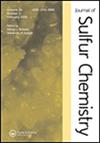Synthesis of 3-(1H-benzo[d]imidazole-2-yl)-2-arylthiazolidin-4-one using Fe3O4@SiO2Pr@E-N'-(4-hydroxy-3-methoxybenzylidene) isonicotinohydrazide@Cu an efficient and magnetically retrievable nanocatalyst
IF 1.6
3区 化学
Q3 CHEMISTRY, MULTIDISCIPLINARY
引用次数: 0
Abstract
Fe3O4@SiO2Pr@E-N'-(4-hydroxy-3-methoxybenzylidene) isonicotinohydrazide@Cu were prepared and were analyzed by XRD, FT-IR, VSM, TEM, FE-SEM, and TGA-DTG analysis. These nano catalysts were applied as an efficient and magnetically reusable nanocatalyst for the preparation of various derivatives of thiazolidinones under solvent-free conditions. All of the organic compounds were analyzed by NMR and FT-IR. This avenue offers many benefits, such as productivity, fast reaction, and convenience for work and recovery. The catalyst is reusable for 8 runs by decantation using an efficient magnet without notable loss in activity. This protocol has many advantages, like working better, quickly responding, and making it easy to work. This is the first report to use Fe3O4@SiO2Pr@E-N'-(4-hydroxy-3-methoxybenzylidene) isonicotinohydrazide@Cu to make 3-(1H-benzo[d]imidazole-2-yl)-2-arylthiazolidin-4-ones. The reaction speed is good, and this method works well. The reaction was done without any liquid and in an environmentally friendly and gentle way. The method explained is totally new.
利用Fe3O4@SiO2Pr@E-N'-(4-羟基-3-甲氧基苄基苄基)isonicotinohydrazide@Cu高效磁可回收纳米催化剂合成3-(1h -苯并[d]咪唑-2-基)-2-芳基噻唑烷-4- 1
制备了@E-N′-(4-羟基-3-甲氧基苄基)isonicotinohydrazide@Cu,并对其进行了XRD、FT-IR、VSM、TEM、FE-SEM和TGA-DTG分析。这些纳米催化剂作为一种高效的磁性可重复使用的纳米催化剂,在无溶剂条件下用于制备噻唑烷酮的各种衍生物。所有有机化合物均通过NMR和FT-IR进行了分析。这条路有很多好处,比如效率高、反应快、工作和恢复方便。该催化剂可重复使用8次,使用高效磁体进行滗析,没有明显的活性损失。该协议有很多优点,比如工作更好、响应更快、工作更容易。本文首次报道了利用Fe3O4@SiO2Pr@E-N'-(4-羟基-3-甲氧基苄基苄基)isonicotinohydrazide@Cu合成3-(1h -苯并[d]咪唑-2-基)-2-芳基噻唑烷-4-酮的方法。反应速度快,效果好。该反应是在没有任何液体的情况下以一种环保和温和的方式完成的。所解释的方法是全新的。
本文章由计算机程序翻译,如有差异,请以英文原文为准。
求助全文
约1分钟内获得全文
求助全文
来源期刊

Journal of Sulfur Chemistry
CHEMISTRY, MULTIDISCIPLINARY-
CiteScore
4.10
自引率
9.10%
发文量
38
审稿时长
6-12 weeks
期刊介绍:
The Journal of Sulfur Chemistry is an international journal for the dissemination of scientific results in the rapidly expanding realm of sulfur chemistry. The journal publishes high quality reviews, full papers and communications in the following areas: organic and inorganic chemistry, industrial chemistry, materials and polymer chemistry, biological chemistry and interdisciplinary studies directly related to sulfur science.
Papers outlining theoretical, physical, mechanistic or synthetic studies pertaining to sulfur chemistry are welcome. Hence the target audience is made up of academic and industrial chemists with peripheral or focused interests in sulfur chemistry. Manuscripts that truly define the aims of the journal include, but are not limited to, those that offer: a) innovative use of sulfur reagents; b) new synthetic approaches to sulfur-containing biomolecules, materials or organic and organometallic compounds; c) theoretical and physical studies that facilitate the understanding of sulfur structure, bonding or reactivity; d) catalytic, selective, synthetically useful or noteworthy transformations of sulfur containing molecules; e) industrial applications of sulfur chemistry; f) unique sulfur atom or molecule involvement in interfacial phenomena; g) descriptions of solid phase or combinatorial methods involving sulfur containing substrates. Submissions pertaining to related atoms such as selenium and tellurium are also welcome. Articles offering routine heterocycle formation through established reactions of sulfur containing substrates are outside the scope of the journal.
 求助内容:
求助内容: 应助结果提醒方式:
应助结果提醒方式:


